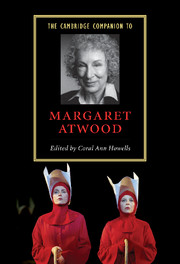Book contents
- Frontmatter
- Introduction
- 1 Margaret Atwood in her Canadian context
- 2 Biography/autobiography
- 3 Power politics: power and identity
- 4 Margaret Atwood’s female bodies
- 5 Margaret Atwood and environmentalism
- 6 Margaret Atwood and history
- 7 Home and nation in Margaret Atwood’s later fiction
- 8 Margaret Atwood’s humor
- 9 Margaret Atwood’s poetry and poetics
- 10 Margaret Atwood’s short stories and shorter fictions
- 11 Margaret Atwood’s dystopian visions: The Handmaid’s Tale and Oryx and Crake
- 12 Blindness and survival in Margaret Atwood’s major novels
- Further Reading
- Index
11 - Margaret Atwood’s dystopian visions: The Handmaid’s Tale and Oryx and Crake
Published online by Cambridge University Press: 28 November 2006
- Frontmatter
- Introduction
- 1 Margaret Atwood in her Canadian context
- 2 Biography/autobiography
- 3 Power politics: power and identity
- 4 Margaret Atwood’s female bodies
- 5 Margaret Atwood and environmentalism
- 6 Margaret Atwood and history
- 7 Home and nation in Margaret Atwood’s later fiction
- 8 Margaret Atwood’s humor
- 9 Margaret Atwood’s poetry and poetics
- 10 Margaret Atwood’s short stories and shorter fictions
- 11 Margaret Atwood’s dystopian visions: The Handmaid’s Tale and Oryx and Crake
- 12 Blindness and survival in Margaret Atwood’s major novels
- Further Reading
- Index
Summary
All fictions begin with the question What if. The what if varies from book to book . . . but there is always a what if, to which the novel is the answer.
Atwood's hypothesis about narrative beginnings assumes a particular urgency in relation to her two near-future novels, The Handmaid's Tale (1985) and Oryx and Crake (2003), for both of them are an imaginative writer's response to contemporary situations of cultural crisis as they suppose what may happen at what Atwood has called “definitive moments” after which “things were never the same again.” Already the shifts between past, present, and future in my opening remarks will have illustrated the distinctive qualities of the genre to which these two novels belong, namely the dystopia. Perhaps the primary function of a dystopia is to send out danger signals to its readers: “Many dystopias are self-consciously warnings. A warning implies that choice, and therefore hope, are still possible.” This chapter will focus on Atwood's two dystopian novels, their narrators and narrative techniques, arguing that together they represent a synthesis of her political, social, and environmental concerns transformed into speculative fiction. They are embedded in very different historical contexts: The Handmaid's Tale is a product of the 1980s, focusing on the possible consequences of neo-conservative religious and political trends in the United States, while Oryx and Crake written at the beginning of the twenty-first century projects not a national disaster but a global catastrophe “in a world that has become one vast uncontrolled experiment.”
- Type
- Chapter
- Information
- The Cambridge Companion to Margaret Atwood , pp. 161 - 175Publisher: Cambridge University PressPrint publication year: 2006
- 19
- Cited by



